Low Carr Farm 22nd June 2016
Plant list below
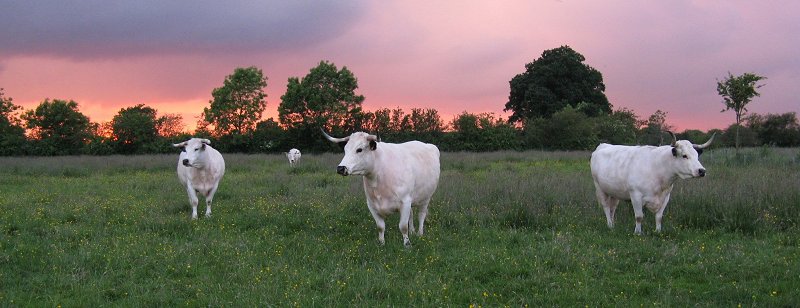
Back to the Home page
A warm summer’s evening provided 12 members with the perfect weather for a walk around Yorkshire Wildlife Trust’s farm near Pickering. By a remarkable coincidence the farm was bequeathed to the Trust exactly 16 years to the date of the event on the 22nd of June 2000. At a little under 45 hectares, almost all the holding is permanent grassland, managed as cattle/sheep pasture or hay meadow. The modest improvements to the meadows over the years, with no fertiliser inputs other than occasional farm muck, has resulted in some magnificent hay meadows that are at their best in late June. The extensive botanical list below is confirmation of this rich floristic treasure trove that is now rare in the Vale of Pickering. Beyond the meadows lies Costa Beck, a calcareous stream fed by springs at Keld Head near Pickering. The Carrs alongside the beck consist of rough grassland that would have been flooded in winter prior to the Costa being canalised in the early 60s. The old meander channels are still visible and now form damp areas that support diverse plant communities favouring permanently wet conditions. The farm is in High Level Stewardship.
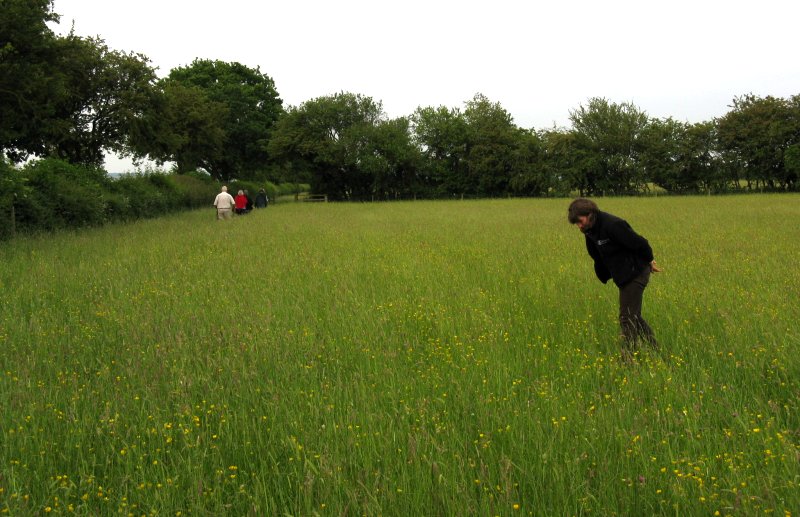
The site is primarily used by the Trust as a holding place for a variety of cattle and sheep that are used on many of its reserves to control vegetation. Walking around the fields there were large flocks of Hebridean sheep that we were told would be off to reserves soon, also White Park and Highland cattle; the later happy to allow members to touch them despite their fierce looking horns.
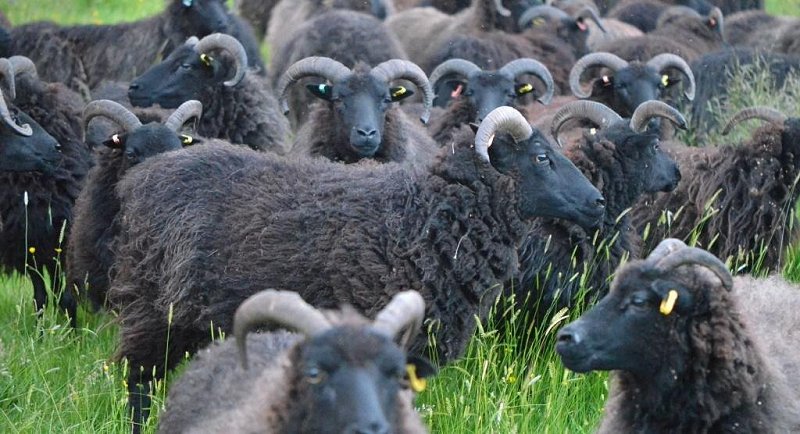
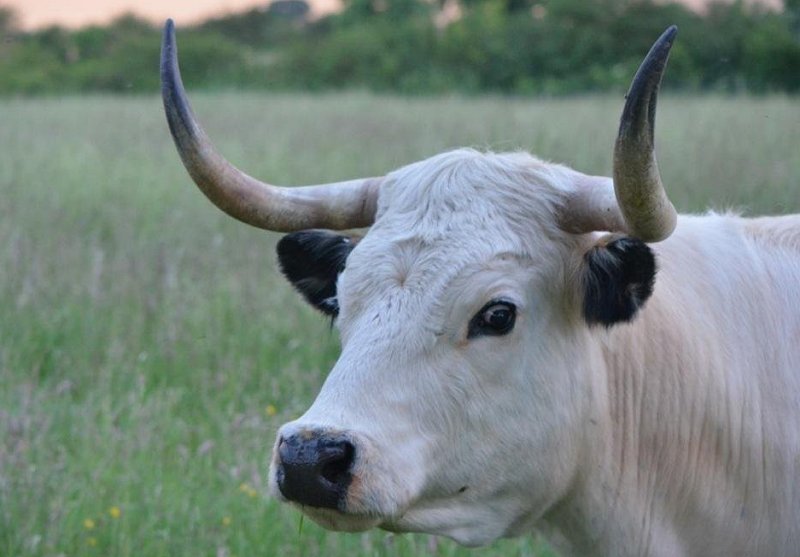
In mid-July the hay meadows are cut and the haylage sold, providing a modest income that helps towards the running of the farm. The Trust’s farm manager, Ellen Fairbank, was on hand to tell us of the work of the farm and to guide us around the land, explaining the balance between running a commercial farm while maintaining a strong conservation brief. We are most grateful to Ellen for allowing us to visit the farm and freely giving her time.
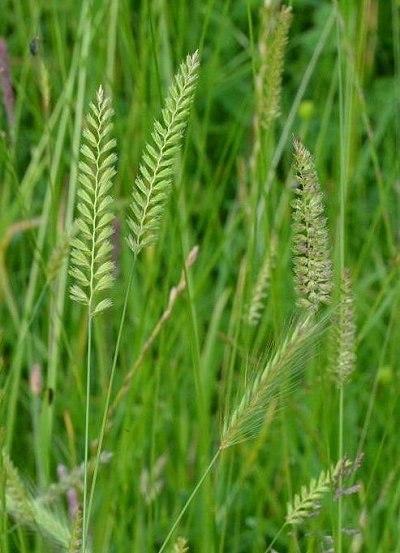 Crested dogstail and Meadow barley grasses (above) |
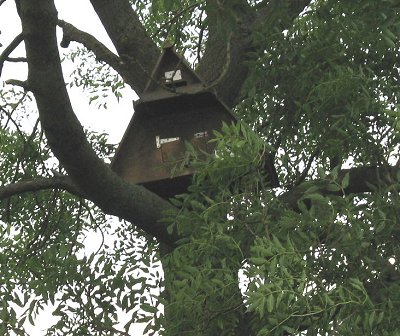 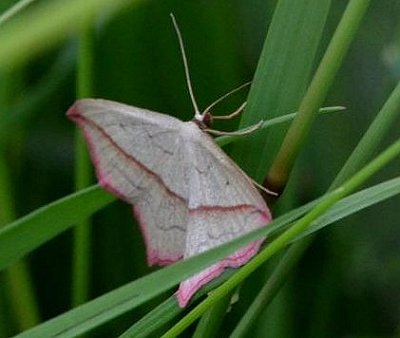
|
Not surprising is the rather ‘thin’ bird list. Late June is a somewhat quiet period for song birds though the following were recorded around the farm during the visit. Blackbird, Robin, Wood Pigeon, Rook, Wren, Willow Warbler, Buzzard, Chiffchaff, Chaffinch, Dunnock, Yellowhammer, Swallow, Swift, Whitethroat. We did not see the owls, but we did see the barn owl box in a large tree.
It was interesting to see such an old-fashioned hayfield, all too rare these days. A particular gem for me was the Meadow Barley, a plant I’ve not seen before. I believe this is right at its northern limit in Britain. If we had had more time I would like to have explored the wet areas down by the river further: I suspect there are many more plants such as sedges growing there that we did not explore fully.[Ed]
| Latin name | Common name |
|---|---|
| Ajuga reptans | Bugle |
| Alliaria petiolata | Hedge Garlic or Jack by the Hedge |
| Alopecurus geniculatus | Foxtail, Marsh |
| ? Alopecurus myosuroides | Foxtail, Slender |
| Alopecurus pratensis | Foxtail, Meadow |
| Anthoxanthum odoratum | Sweet Vernal Grass |
| Anthriscus sylvestris | Cow parsley |
| Arctium minus | Burdock |
| Arrhenatherum elatius | Oat, False |
| Bellis perennis | Daisy |
| Bromus mollis (Bromus hordeaceus) | Brome, Soft |
| Cardamine pratensis | Cuckoo flower or Milkmaid |
| Carex flacca | Glaucous sedge |
| Carex ovalis | Oval sedge |
| ? Carex pallescens | Pale sedge |
| Carex panicea | Carnation sedge |
| Carex viridula | Yellow sedge |
| Centaurea nigra | Knapweed, common |
| Cerastium fontanum | Mouse ear, common |
| Chaerophyllum temulem | Rough chervil |
| Cirsium arvense | Thistle, creeping |
| Cirsium palustre | Thistle, marsh |
| Cirsium vulgare | Thistle, spear |
| Corylus avellana | Hazel |
| Crataegus monogyna | Hawthorn |
| Cruciata laevipes | Crosswort |
| Cynosurus cristatus | Crested Dogstail |
| Dactylis glomerata | Cocksfoot |
| Deschampsia caespitosa | Hair Grass, Tufted |
| Eleocharis palustris | Spike-rush, common |
| Epilobium hirsutum | Willowherb, great |
| ? Epilobium tetragonum | Willowherb, square-stalked |
| Festuca rubra | Fescue, Red |
| Fraxinus excelsior | Ash |
| Galium aparine | Cleavers |
| Galium palustre | Bedstraw, marsh |
| Geranium robertianum | Herb robert |
| Glechoma hederacea | Flote-grass |
| Glyceria sp. | Ground ivy |
| Heracleum sphondylium | Hogweed |
| Holcus lanatus | Yorkshire Fog |
| Hordeum secalinum | Barley, Meadow |
| ? Juncus articulatus | Jointed Rush |
| Juncus conglomeratus | Compact Rush |
| Juncus effusus | Soft Rush |
| Juncus inflexus | Hard Rush |
| Leucanthemum vulgare | Oxeye daisy or Dog Daisy |
| Lolium perenne | Rye Grass, Perennial |
| Malus sylvestris | Crab apple |
| Myosotis laxa | Forgetmenot, tufted |
| Persicaria amphibia | Bistort, amphibious |
| Phalaris arundinacea | Reed Grass |
| Phleum pratense | Timothy |
| Plantago lanceolata | Plantain, ribwort |
| Plantago major | Plantain, greater |
| Poa annua | Meadow Grass, Annual |
| Poa trivialis | Meadow Grass, Rough |
| Potentilla anserina | Silverweed |
| Potentilla reptans | Cinquefoil, creeping |
| Prunella vulgaris | Self heal |
| Prunus avium | Wild cherry |
| Prunus domestica | Wild plum |
| Prunus spinosa | Blackthorn |
| Quercus sp. | Oak |
| Ranunculus acris | Buttercup, meadow |
| Ranunculus flammula | Spearwort, lesser |
| Ranunculus repens | Buttercup, creeping |
| Rhinanthus minor | Yellow rattle |
| Rosa canina | Rose, dog |
| Rubus fruticosus | Bramble |
| Rumex acetosa | Sorrel, common |
| Rumex crispus | Dock, curled |
| Rumex obtusifolius | Dock, broad leaved |
| Rumex sanguineus | Dock, wood |
| Salix sp. | Willow, probably hybrid between crack and bay |
| Sambucus nigra | Elder |
| Solanum dulcamara | Bittersweet |
| Stachys sylvatica | Woundwort, hedge |
| Taraxacum sp. | Dandelion |
| Trifolium dubium | Trefoil, lesser |
| Trifolium pratense | Clover, red |
| Trifolium repens | Clover, white |
| Typha latifolia | Reedmace, common |
| Ulmus glabra | Elm, wych |
| Urtica dioica | Nettle, common |
| Vicia cracca | Vetch, tufted |
| Vicia sepium | Vetch, bush |
| © Ryedale Natural History Society 2016. Photos © Gill Smith, David Lewis 2016 |